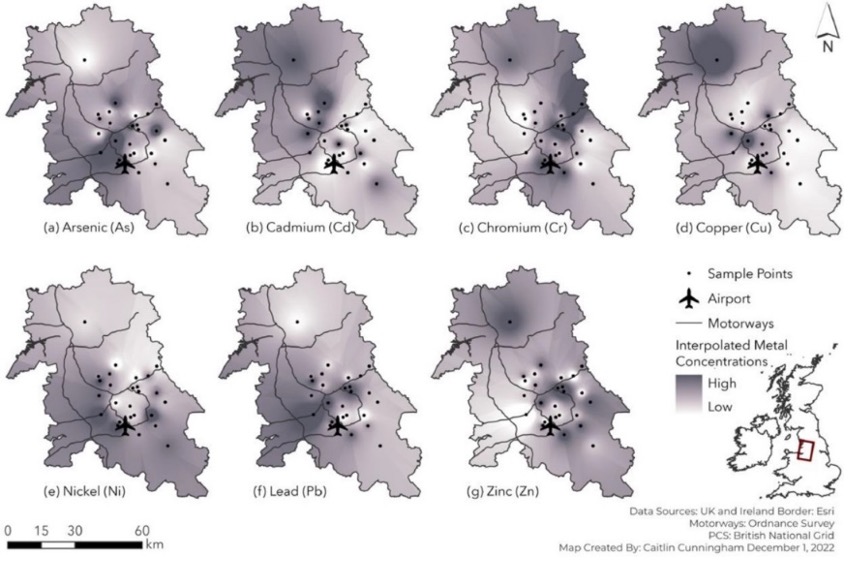Citizen science biomonitoring of metal(loid) pollution in honey from Northwest England
DOI:
https://doi.org/10.48797/sl.2025.333Keywords:
Selected Oral CommunicationAbstract
Background: Honey can be used to biomonitor contaminants, as honeybees can bioaccumulate both organic and inorganic (e.g., metal(loid)) contaminants from the total environment [1]. Honey chemical composition can be influenced by natural and anthropogenic activities [2]. Objective: Metal(loid) concentrations in honey samples collected by citizen scientist beekeepers in northwest England during fall 2018 were measured to assess potential sources from current and historical land use [3]. Methods: Spatial distribution of honey metal(loid) concentrations was assessed using a geographic information system (GIS) using postal codes to identify beehive locations of citizen scientists and analyzed using inductively coupled plasma mass spectrometry (ICP-MS). GIS tools were used to correlate metal(loid) concentrations with local pollution point sources and soil geochemistry databases [3]. Results: Metal(loid) concentrations in honey measured in the Greater Manchester area varied widely (Figure 1). The Greater Manchester area had higher mean As and Cd concentrations in honey (180 µg/kg and 398 µg/kg, respectively) compared to global means 25 µg/kg and 150 µg/kg, respectively), but mean honey Cu, Pb and Zn concentrations were lower (225 µg/kg, 260 µg/kg and 426 µg/kg, respectively) than global means (1005 µg/kg, 1470 µg/kg and 8545 µg/kg, respectively). Cd and Pb concentrations in honey measured in the Greater Manchester area were 398 and 260 µg/kg, respectively, which are up to two orders of magnitude higher than the recommended World Health Organization (WHO) and Food and Agriculture Organization (FAO) guidelines, which may warrant further study to determine potential health impacts from honey consumption. Landscape analysis showed no correlation between metal(loid) contaminants and beehive location. Conclusions: This baseline study demonstrates that honey collected by citizen scientists can be used as an effective environmental biomonitoring tool to analyze metal(loid) contaminants in honey samples in urban areas.
Figure 1. Patterns of interpolated relative concentrations of arsenic (a), cadmium (b), chromium (c), copper (d), nickel (e), lead (f), and zinc (g) across Manchester and surrounding area, UK. Sources for data layers on the map: UK and Ireland borders: Esri, Motorways: Ordnance Survey. Projected Coordinate System: British National Grid. Map created using ArcGIS Pro v. 3.0.2.
References
1. Smith, K.E. et al. Honey as a biomonitor for a changing world. Nat Sustain 2019, 2, 223–232, doi: 10.1038/s41893-019-0243-0.
2. Giglio, A. et al. Apis mellifera ligustica, Spinola 1806 as bioindicator for detecting environmental contamination: a preliminary study of heavy metal pollution in Trieste, Italy. Environ Sci Pollut Res 2017, 24, 659-665, doi: 10.1007/s11356-016-7862-z.
3. Shaw, J. et al. Biomonitoring of honey metal(loid) pollution in Northwest England by citizen scientists. Environ Adv 2023, 13, 100406, doi: 10.1016/j.envadv.2023.100406
Downloads
Published
How to Cite
Issue
Section
License
Copyright (c) 2025 Tony Walker, Jillian Shaw, Caitlin Cunningham, Abby Ragazzon-Smith, Paul R. Lythgoe, Simon Harper

This work is licensed under a Creative Commons Attribution 4.0 International License.
In Scientific Letters, articles are published under a CC-BY license (Creative Commons Attribution 4.0 International License), the most open license available. The users can share (copy and redistribute the material in any medium or format) and adapt (remix, transform, and build upon the material for any purpose, even commercially), as long as they give appropriate credit, provide a link to the license, and indicate if changes were made (read the full text of the license terms and conditions of use).
The author is the owner of the copyright.









